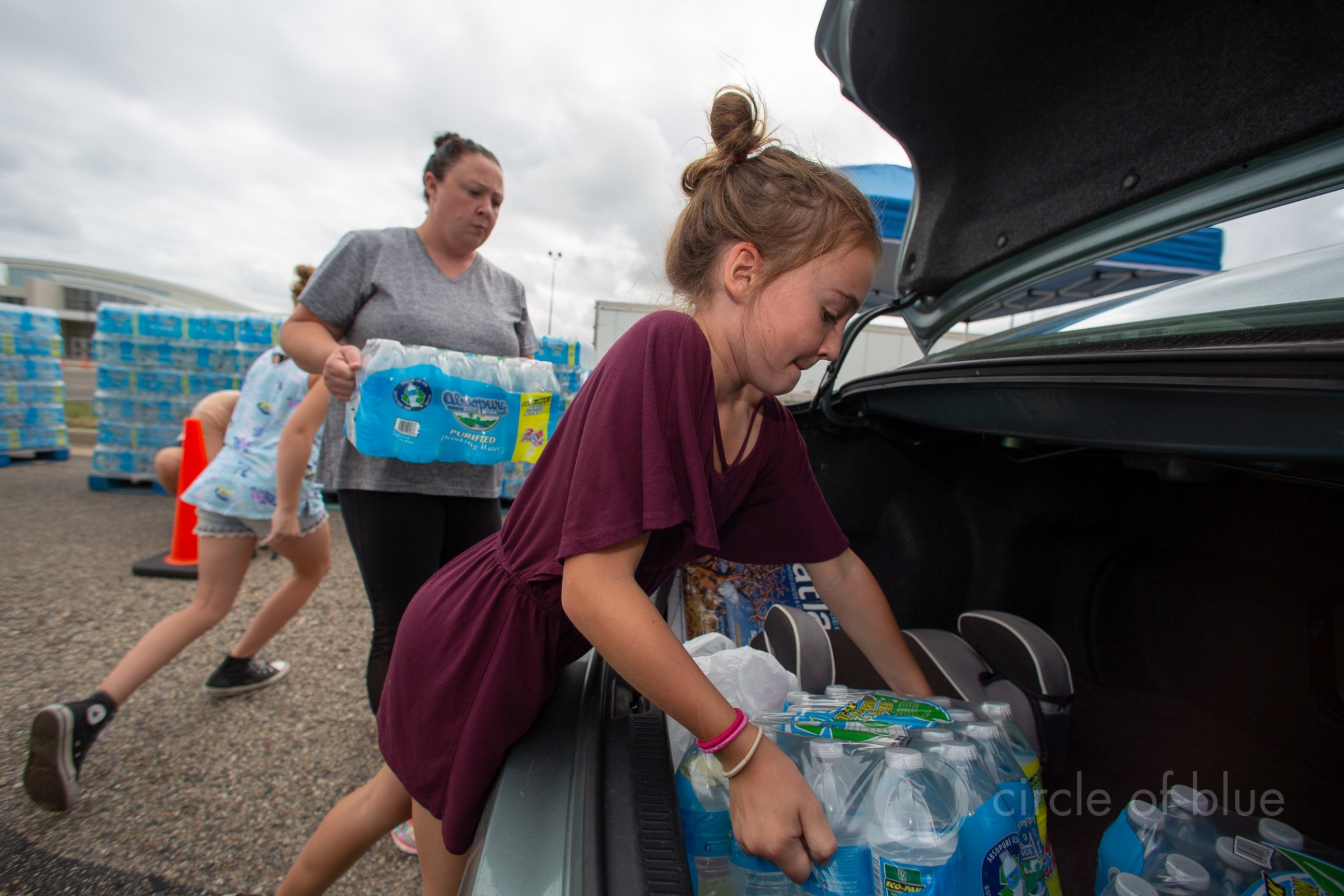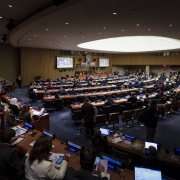In Senate PFAS Hearing, Government Officials Say Regulatory Response Will Take Years
Residents of affected communities want quicker action.

Residents in Parchment, Michigan, pick up bottled water in August after high levels of PFAS chemicals were found in the town’s wells. Photo © J. Carl Ganter/Circle of Blue
By Brett Walton, Circle of Blue
Despite pleas for immediate action from Michigan and New Hampshire residents who live in communities with PFAS-contaminated groundwater, officials from multiple federal agencies testified at a U.S. Senate subcommittee hearing that regulatory responses and health studies will take years to complete.
While the U.S. Environmental Protection Agency is considering multiple major regulatory actions for PFAS chemicals, Peter Grevatt, head of the Office of Ground Water and Drinking Water, said not to expect any changes to the agency’s existing drinking water guidance: an unenforceable health advisory for PFOA and PFOS, the two most-studied of the thousands of PFAS compounds.
“We’re not currently planning to update the drinking water health advisories for PFOA and PFOS,” Grevatt told the members of a Homeland Security and Governmental Affairs subcommittee on September 26. Though not a regulatory standard, the health advisories have been used by the Defense Department as a threshold for supplying bottled water and filters to homes with wells contaminated by PFAS from military bases.
Used to produce non-stick skillets, water-repelling jackets, and firefighting foams, PFAS chemicals are linked in humans to cancers of the kidneys and testicles, thyroid disease, high cholesterol, and immune system breakdowns.
Residents who testified said they see states setting their own drinking water standards and want no more delays from federal agencies.
“Communities need action now and cannot wait any longer,” said Andrea Amico, co-founder of Testing for Pease, a New Hampshire pressure group that was established following discovery of PFAS contamination at the former Pease Air Force Base.
Grevatt defended the health advisory, lowered in 2016 to 70 parts per trillion, as being “supported by the strongest science.”
Some senators questioned the accuracy of that statement by pointing to an Agency for Toxic Substances Disease Registry report published in July. The report indicated that PFOA and PFOS may damage human health at levels 10 times lower than the health advisory. Grevatt said that the values represent a “screening approach” — levels above which more investigation should take place — and not a health standard. And yet, states like New Jersey have drinking water standards as low as 14 parts per trillion for PFOA, while others are higher. Those discrepancies have led to calls for a national standard.
The U.S. Environmental Protection Agency is weighing two major regulatory actions, Grevatt said. The agency could classify PFAS chemicals, individually or in groups, as hazardous wastes. Doing so would allow EPA staff to order cleanups at contaminated sites and force the polluters to pay the cost.
The other potential action is a national drinking water standard for PFAS chemicals. The EPA decides to issue a national drinking water standard based on three criteria: if the contaminant may harm health, if it occurs frequently enough that it is a national issue, and if the administrator feels that regulation is a “meaningful opportunity” to reduce risk.
“It’s really those last two criteria that are the ones that the administrator is thinking very carefully about now,” Grevatt said, referring to Andrew Wheeler, the acting EPA administrator since July, when Scott Pruitt resigned. The main consideration: does the EPA need a national rule with testing and sampling requirements that all utilities must follow? Or will local statutes suffice?
Both the hazardous waste designation and the drinking water standard must go through the regulatory review process, which means a proposed rule, followed by a public comment period, and then a final rule. It is not a speedy process.
“We’re talking about years before we can get that completed,” Grevatt said.
Grevatt said that a road map for the agency’s response will be included in a PFAS management plan that is scheduled to be completed by the end of the year.
An action that could come sooner is a national groundwater cleanup guidance, which the EPA has sent for interagency review. The guidance is not binding, but it is something that the Defense Department has requested because it sets a national framework for cleanups, said Maureen Sullivan, who is overseeing the department’s PFAS response.
“Consistent guidance from EPA would be extremely helpful, not only for us but all of the entities that have sources of PFOS and PFOA,” Sullivan said.
Even if the EPA chooses not to regulate PFAS chemicals, Congress could force its hand. Sen. Kristen Gillibrand of New York introduced a bill in 2017 that would require a federal drinking water standard for PFOA and PFOS, but the bill has not moved out of committee. Several senators at the hearing on Wednesday asked questions about the timeline for EPA’s regulatory actions.
The timeline for health studies is also long. The Agency for Toxic Substances and Disease Registry is in the initial stages of a health assessment of people exposed to PFAS chemicals on eight military bases. Because of its complexity, that study will take at least five years, according to Linda Birnbaum, director of the National Institute of Environmental Health Sciences and National Toxicology Program.
“We’re looking at quite a number of years before we’ll have data from those studies,” Birnbaum said.
The hearing was requested by Sen. Gary Peters of Michigan, where PFAS chemicals have been found at 35 sites.
“I asked for this hearing because I believe that everyone in this great country should have access to safe drinking water — and I want to do everything I can to ensure the federal government is effectively managing this crisis,” Peters said. The committee heard testimony from Arnie Leriche, a resident of Oscoda, a northern Michigan town that is struggling with PFAS contamination in groundwater, rivers, and lakes. The chemicals are coming from firefighting foams used decades ago at the former Wurtsmith Air Force Base.
Grevatt announced that the EPA plans to hold a community meeting in Michigan on October 4 and 5 to discuss PFAS contamination. The agency held similar meetings this summer in five states. Grevatt did not know the location of the meeting.
Brett writes about agriculture, energy, infrastructure, and the politics and economics of water in the United States. He also writes the Federal Water Tap, Circle of Blue’s weekly digest of U.S. government water news. He is the winner of two Society of Environmental Journalists reporting awards, one of the top honors in American environmental journalism: first place for explanatory reporting for a series on septic system pollution in the United States(2016) and third place for beat reporting in a small market (2014). He received the Sierra Club’s Distinguished Service Award in 2018. Brett lives in Seattle, where he hikes the mountains and bakes pies. Contact Brett Walton











Leave a Reply
Want to join the discussion?Feel free to contribute!